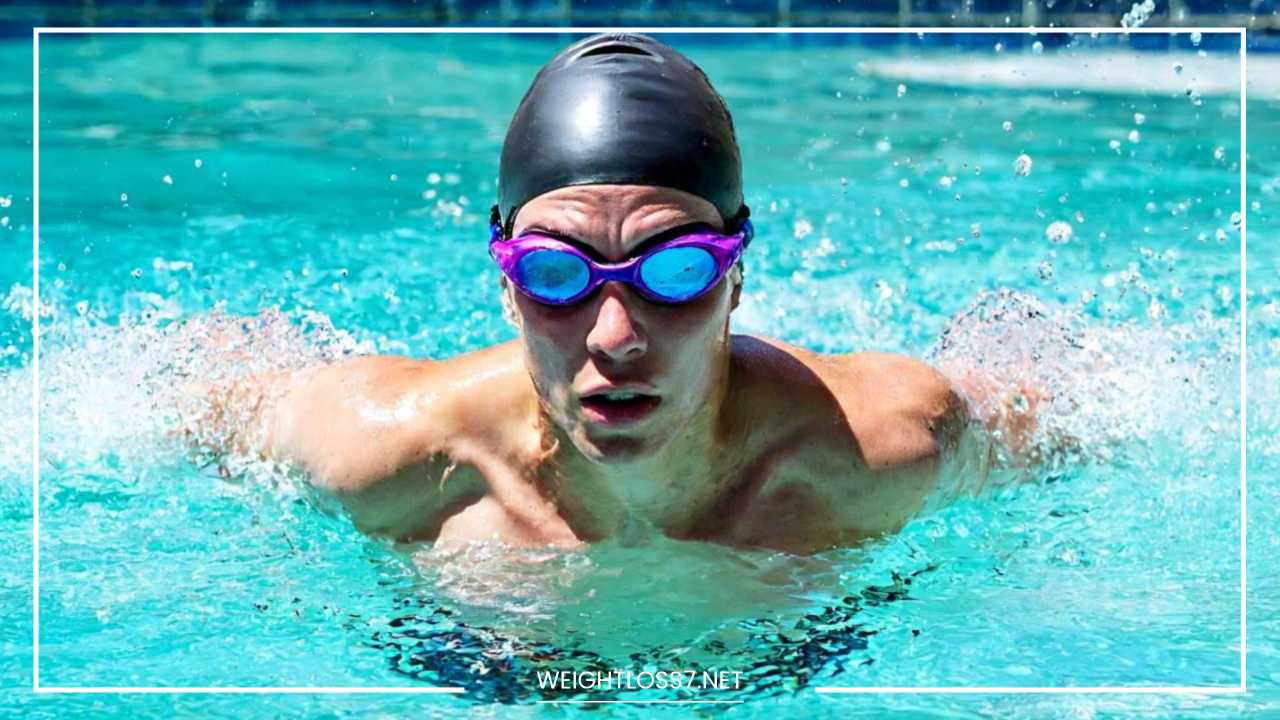30-minute Pool Workout

30-minute Pool Workout
Dive into Fitness: A Pool Workout for Weight Loss
Water workouts are an exciting and efficient way to lose weight, build muscle, and enhance cardiovascular fitness, all while protecting your joints.
The natural resistance of water creates a challenging yet low-impact exercise environment, allowing individuals of all fitness levels to work out more intensely than they might be able to on land.
Whether you’re an experienced swimmer or a complete beginner, a structured pool workout can help you burn calories, tone your body, and enjoy the many other health benefits that aquatic exercise offers.
Why Choose Water Workouts for Weight Loss?
Water-based workouts aren’t just for swimmers or people recovering from injuries—they are a powerful tool for weight loss, toning, and improving overall fitness.
If you haven’t considered water exercise as part of your weight-loss strategy, it’s time to dive in. Below are the main reasons why water workouts are so effective for burning fat and improving fitness.
1. Low-Impact, High-Intensity Exercise
One of the biggest advantages of water-based workouts is that they are incredibly low-impact. The buoyancy of water supports your body and reduces the stress placed on your joints, making water workouts ideal for people with joint issues, arthritis, or those who are overweight.
This makes aquatic exercises a safe alternative to higher-impact activities like running or weightlifting, especially for people new to exercise or those with existing injuries.
Despite being gentle on your joints, water workouts are still high-intensity. The natural resistance of the water forces your body to work harder, providing a full-body workout that can be more intense than similar exercises on land.
For example, walking or jogging in the pool is more challenging than doing so on a treadmill because of the resistance created by the water, leading to greater calorie expenditure.
2. Increased Calorie Burn
Water’s resistance plays a significant role in increasing calorie burn. Every movement you make in the water is met with resistance, forcing your muscles to engage more and expend more energy. This added effort increases the number of calories you burn during your workout.
Studies have shown that swimming and water aerobics can burn just as many, if not more, calories than land-based exercises.
For example, an hour of moderate-intensity swimming can burn between 400 and 700 calories depending on the intensity and the swimming stroke you use.
The greater resistance in water means you’re getting more muscle engagement with less effort.
Additionally, water keeps your body cool, so you can push yourself harder and longer without overheating, which often leads to a greater calorie burn over time.
3. Improved Cardiovascular Health
Water-based workouts are great for cardiovascular conditioning. When you engage in water exercises, your heart rate increases, which strengthens your cardiovascular system and improves circulation. This is beneficial not only for weight loss but also for overall heart health.
The cooling effect of water helps to prevent overheating during your workout, enabling you to exercise for longer periods.
The buoyancy of the water also reduces the load on your heart, which means you can perform a longer cardio session without feeling overly fatigued.
Whether you’re swimming laps, running in place, or performing water aerobics, your cardiovascular endurance improves, which helps reduce your risk of heart disease and other chronic conditions.
4. Enhanced Muscle Tone and Strength
Water provides continuous resistance that helps to tone and strengthen muscles. The density of water is about 800 times denser than air, which means every movement you make is met with resistance.
This resistance helps to target and tone muscles without the need for heavy weights or machines.
Regular water workouts can increase muscle strength and endurance across the entire body. Swimming strokes like the freestyle and breaststroke engage your core, arms, and legs, while activities like water aerobics and resistance exercises (such as water push-ups or squats) help tone muscles in the lower and upper body.
The added resistance builds strength and muscle tone, all while helping to maintain flexibility and balance.
5. Stress Relief and Mental Health Benefits
In addition to physical benefits, water workouts can have a significant impact on mental health. Swimming, in particular, has been shown to reduce stress and improve mood due to the combination of rhythmic movement, deep breathing, and the soothing nature of water.
Water exercises also promote the release of endorphins, which can help alleviate feelings of anxiety and depression.
The meditative quality of water-based exercise—whether you’re swimming laps or simply floating—is known to help reduce cortisol, the hormone linked to stress. By incorporating regular water workouts into your routine, you can enjoy both mental and physical well-being.
How to Build an Effective Pool Workout Routine
Creating an effective pool workout for weight loss and fitness involves combining a variety of exercises that target both cardio fitness and strength development.
A well-rounded pool routine should focus on increasing your heart rate, strengthening muscles, and improving flexibility. Below is a comprehensive pool workout routine, suitable for both beginners and advanced fitness levels.
1. Warm-Up (5-10 Minutes)
Just like any other workout, it’s important to begin with a warm-up to prepare your body for more strenuous exercise.
The warm-up increases blood flow to your muscles, helps prevent injury, and enhances your performance during the workout.
- Light Jogging or Water Walking: Start by walking or jogging in the shallow end of the pool. Focus on getting your body moving and your heart rate slightly elevated. Walking in the water increases the intensity by adding resistance with each step.
- Arm Circles: Stand with your feet shoulder-width apart in the shallow end and extend your arms to the sides. Perform small, controlled arm circles for 10-15 repetitions in each direction. This will help warm up your shoulders and upper body.
- Leg Swings: Holding onto the pool edge or a noodle for balance, swing each leg forward and backward to loosen up your hips and hamstrings. Perform 10 swings per leg.
- Torso Twists: Stand with your feet shoulder-width apart and gently twist your torso from side to side, engaging your core. This warms up your abdominal muscles and gets your spine moving.
2. Cardio (20-30 Minutes)
The cardio portion of your pool workout is essential for burning calories, improving cardiovascular health, and enhancing endurance. Here are a few ways to incorporate cardio into your pool routine:
- Water Running or Jogging: Increase the pace from your warm-up to a brisk jog or run in the shallow end of the pool. Focus on lifting your knees high and pumping your arms to maximize intensity. Running against the resistance of the water adds a challenge that boosts calorie burn. Try intervals: sprint for 30 seconds, then slow down for 30 seconds to recover, and repeat for 20-30 minutes.
- Water Aerobics: Incorporating jumping jacks, high knees, and butt kicks into your pool workout increases your heart rate and engages both your upper and lower body. Water aerobics classes often focus on this kind of high-intensity movement, making them a fun and effective way to lose weight while keeping your muscles engaged.
- Swimming Laps: Swimming is an excellent cardiovascular exercise that also works your entire body. Swim laps using a variety of strokes, such as freestyle, breaststroke, and backstroke. Alternate between fast-paced laps and slower, recovery laps for interval training. Try to swim continuously for 20-30 minutes, adjusting the intensity to your fitness level.
3. Strength Training (15-20 Minutes)
Strength training is key to building lean muscle mass, boosting your metabolism, and toning your body. Water-based strength exercises are challenging yet joint-friendly.
- Water Push-ups: Stand facing the pool wall with your hands placed shoulder-width apart. Lower your chest toward the wall by bending your elbows, and then push back up to the starting position. This move targets your chest, shoulders, and triceps.
- Water Squats: Stand with your feet shoulder-width apart, and squat down in the water, keeping your chest lifted and your knees aligned with your toes. The resistance of the water increases the difficulty of the squat, making it an effective leg exercise.
- Water Lunges: Step forward into a lunge position, ensuring your front knee stays aligned with your ankle, and your back knee nearly touches the pool floor. Push off with your front leg to return to the starting position. Repeat on the other leg. This exercise targets the quads, glutes, and hamstrings.
- Water Rows: Use a pool noodle, resistance band, or water dumbbells to perform rowing motions. Start by holding the resistance tool in front of you, then pull it toward your torso while squeezing your shoulder blades together. This move works your back, shoulders, and arms.
4. Cool-Down (5-10 Minutes)
The cool-down is essential for bringing your heart rate back to normal and preventing muscle soreness.
- Light Swimming or Water Walking: Swim at a slow pace, or walk gently in the shallow end of the pool. This will help relax your muscles and gradually lower your heart rate.
- Stretching: After your cool-down, spend a few minutes stretching the major muscle groups—quadriceps, hamstrings, calves, back, and shoulders. Stretching helps increase flexibility and reduce tension in the muscles.
Additional Tips for a Successful Pool Workout
1. Stay Hydrated: Even though you’re in the water, it’s crucial to stay hydrated. Drink plenty of water before, during, and after your workout. Dehydration can still occur in the water, especially during long or intense sessions.
2. Wear the Right Gear: Invest in a good swimsuit that provides comfort and support. A quality pair of goggles is also essential for keeping your eyes protected from chlorine and helping you see clearly while swimming.
3. Listen to Your Body: Be mindful of how your body feels during the workout. If you’re feeling tired or overly fatigued, take a break. Pushing too hard too soon can lead to injury or burnout.
4. Join a Water Aerobics Class: If you’re looking for structure and motivation, consider joining a water aerobics class. Instructors can guide you through various exercises, and being part of a class can help keep you accountable and motivated.
5. Mix It Up: Variety is key to preventing boredom and ensuring you work all areas of your body. Switch up your exercises, try different strokes while swimming, or experiment with different water resistance equipment.
Maximizing Weight Loss with Pool Workouts
For optimal results in weight loss and fitness, it’s essential to combine regular pool workouts with a healthy lifestyle. Here’s how you can maximize your efforts:
1. Combine with a Healthy Diet: A balanced diet is essential for losing weight and supporting your exercise routine. Focus on eating whole, nutrient-dense foods, including lean proteins, vegetables, fruits, whole grains, and healthy fats. Avoid processed foods, sugary snacks, and excessive alcohol consumption.
2. Get Enough Sleep: Sleep is often overlooked but is crucial for weight loss and overall health. Aim for 7-9 hours of restful sleep each night. Good sleep supports your metabolism, enhances muscle recovery, and regulates hunger hormones.
3. Manage Stress: Chronic stress can negatively affect your weight loss efforts by increasing cortisol levels, which may lead to fat retention, particularly around the abdomen. Incorporate stress-reducing practices like meditation, yoga, or deep breathing into your routine.
Final Thoughts
Water workouts are one of the most effective and enjoyable ways to lose weight, improve fitness, and strengthen muscles.
By taking advantage of the natural resistance of water, you can engage in full-body workouts that are easy on your joints yet challenging enough to burn calories and build strength.
Whether you prefer swimming laps, performing water aerobics, or engaging in water resistance exercises, the pool offers endless possibilities for improving your overall health.
By following a structured pool workout routine and adopting a balanced lifestyle that includes a healthy diet, proper hydration, stress management, and adequate sleep, you can unlock the full potential of water-based exercise and reach your fitness and weight loss goals. So grab your swimsuit, hit the pool, and start your journey toward a fitter, healthier you!

















